Electronic components form the backbone of modern technology, powering everything from smartphones to spacecraft. However, managing these components efficiently can be a challenge, especially for hobbyists and professionals alike.
In this article, we’ll explore effective strategies for organizing electronic components, ensuring smoother projects and enhanced productivity.
Benefits of Organizing Electronic Components
Organizing electronic components offers numerous advantages that contribute to smoother projects and enhanced productivity.
Let’s delve into some of the key benefits:
- Efficiency in Projects: With electronic components neatly organized and readily accessible, engineers, hobbyists, and professionals can significantly reduce the time spent searching for specific parts. This efficiency allows them to focus more on the creative aspects of their projects, leading to faster turnaround times and increased output.
- Cost Savings: Proper organization helps prevent duplicate purchases by ensuring that individuals can easily identify and locate the components they need. By avoiding unnecessary spending on items already in their inventory, they can effectively manage their budgets and allocate resources more efficiently.
- Preventing Damage: Electronic components are sensitive to environmental factors such as moisture, static electricity, and physical impact. By storing components in designated containers with proper insulation and protection, individuals can minimize the risk of damage or degradation. This extends the lifespan of components, reducing the frequency of replacements and contributing to long-term cost savings.
- Enhanced Collaboration: In collaborative environments such as laboratories or workshops, organized storage systems facilitate seamless collaboration among team members. By maintaining a standardized organizational structure and labeling system, individuals can easily communicate and share resources, fostering a more cohesive and productive work environment.
- Streamlined Inventory Management: Organized electronic component storage enables individuals to maintain accurate inventory records and track stock levels more effectively. By knowing exactly what components are available and where they are located, they can avoid stockouts, optimize ordering processes, and minimize delays in project timelines.
The benefits of organizing electronic components extend beyond mere tidiness. By promoting efficiency, cost-effectiveness, and collaboration, proper organization plays a crucial role in maximizing productivity and achieving success in electronics-related endeavors.
Electronic Component Storage Ideas
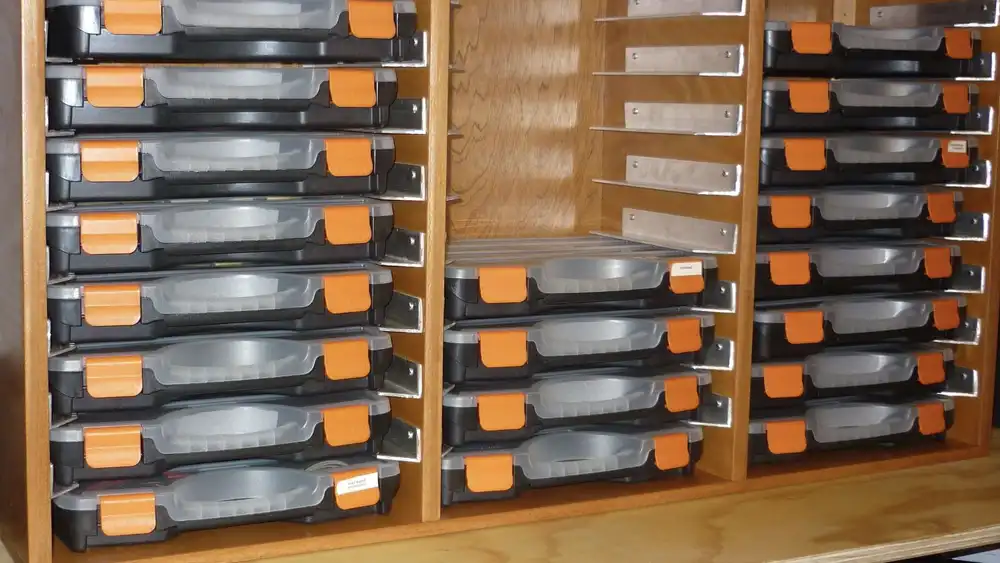
Here’s the revised section with the added electronic component storage solutions, and you can choose the best storage for electronic components for your project according to your electronic component storage requirements.
Organizing electronic components is essential for efficiency and productivity in any workspace. Here are some creative storage ideas to help you keep your electronic components neatly organized and easily accessible:
So that you can choose the most proper electronic component organizer to store your electronic components with safety.
Electronic Component Storage Drawers
Electronic component storage drawers are versatile organizational solutions designed to neatly store and organize electronic components of various sizes. With adjustable dividers and compartments, these drawers provide customizable storage options, allowing users to efficiently categorize and access their components.
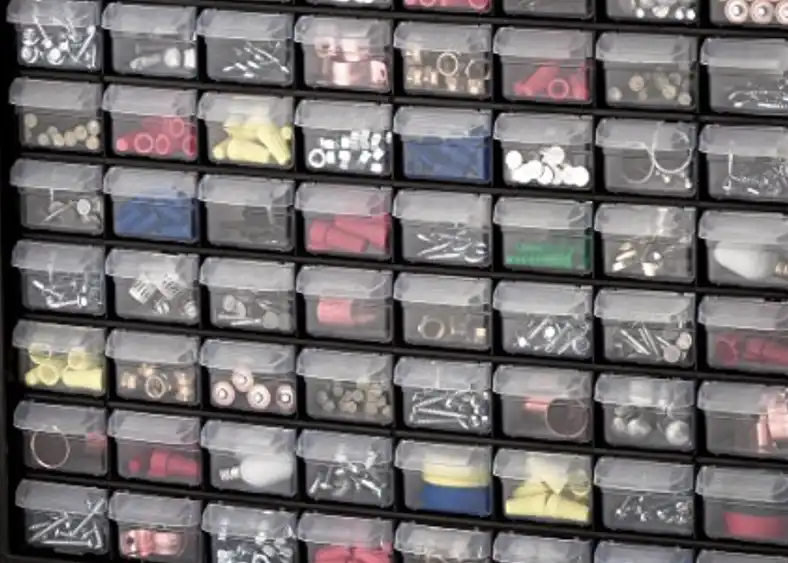
Electronic Component Storage Cabinet
An electronic component storage cabinet is a secure and organized solution for storing electronic parts, offering adjustable shelves and compartments to accommodate various component sizes and quantities.
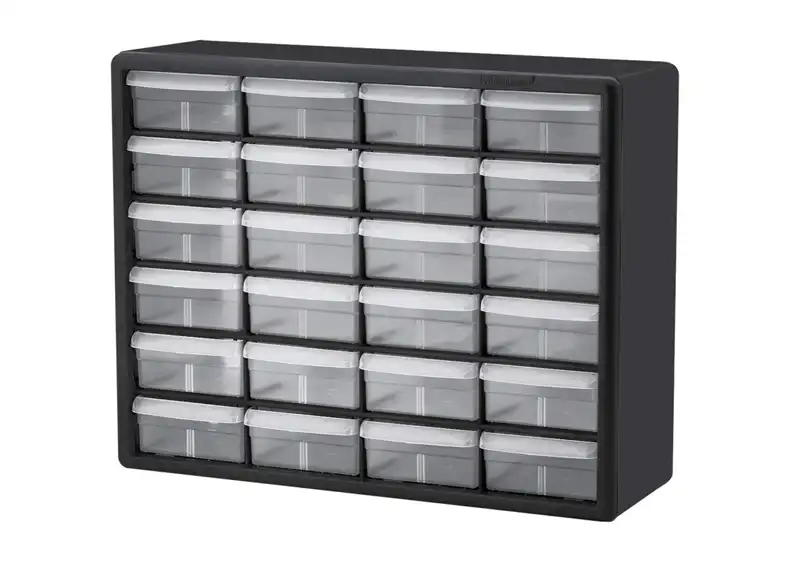
Electronic Components Storage Rack
An electronic components storage rack is a vertical storage solution designed to organize and store electronic parts efficiently. With adjustable shelves or bins, it maximizes space utilization while keeping components easily accessible, making it ideal for workshops and production facilities.
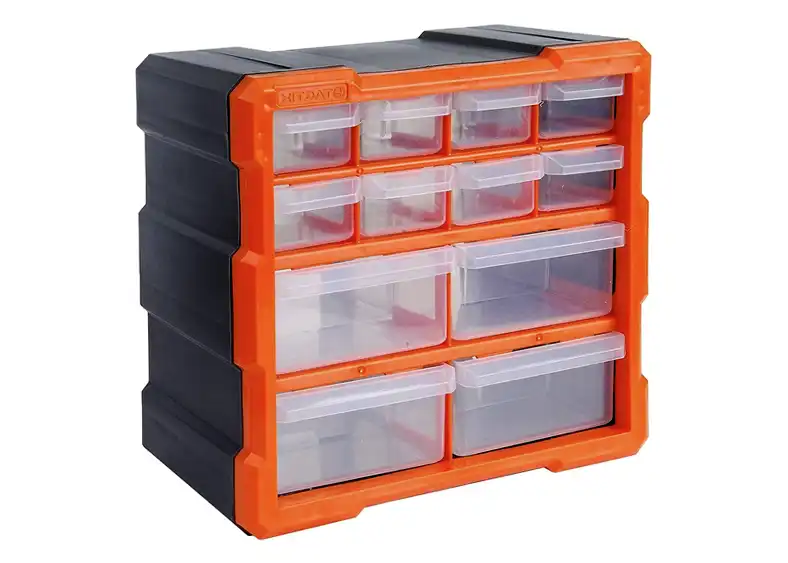
Plastic Storage Box for Electronic Components
An electronic Components Storage Assortment Box for electronic components offers convenient organization and protection for delicate parts, with adjustable compartments to accommodate various sizes.
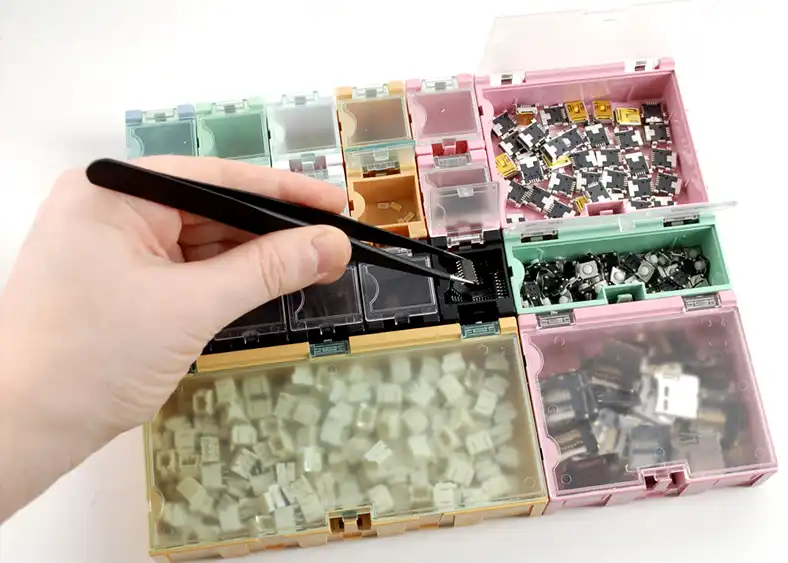
Storage Bins and Drawers: Utilize transparent storage bins and storage drawers for electronic components to categorize and store electronic components based on type, size, or frequency of use. Label each bin or drawer for quick identification and retrieval of components.
Stackable Containers: Stackable containers with adjustable dividers provide flexibility in organizing components of varying sizes. These containers are ideal for storing small electronic parts such as resistors, capacitors, and LEDs.
Compartmentalized Trays: Compartmentalized trays or organizers with multiple compartments are perfect for organizing small electronic components like screws, nuts, bolts, and connectors. These trays can be stacked or stored in cabinets for easy access.
Wall-Mounted Organizers: Maximize vertical space by installing wall-mounted organizers such as pegboards or shelving units. Hang small containers, bins, or hooks on the pegboard to store electronic components neatly while keeping them within reach.
Drawer Inserts: Customize your drawers with inserts or dividers to create designated storage spaces for electronic components. Dividers can help separate different types of components and prevent them from mixing together.
Tackle Boxes or Craft Organizers: Repurpose tackle boxes or craft organizers with multiple compartments to store electronic components. These portable organizers are convenient for hobbyists and DIY enthusiasts who work on projects in different locations.
Labeling Systems: Implement a labeling system using adhesive labels or label makers to clearly mark the contents of each storage container. Include information such as component type, value, and quantity to facilitate easy identification.
Anti-Static Storage Solutions: For sensitive electronic components that are susceptible to static electricity, invest in anti-static storage containers or bags. These specialized containers help protect components from electrostatic discharge (ESD) and prevent damage.
Customized Storage Solutions: Get creative and design custom storage solutions tailored to your specific needs. Build storage racks, shelves, cabinets, or drawers that accommodate the size and quantity of your electronic components, ensuring efficient organization.
Mobile Carts or Tool Chests: Use mobile carts or tool chests with drawers and compartments to store electronic components in a portable and organized manner. These carts are convenient for moving components between workstations or project sites.
Electronic Component Storage Cabinet: Install a dedicated electronic component storage cabinet with adjustable shelves and compartments. Cabinets provide ample storage space and can be locked for security, making them ideal for larger collections or shared workspaces.
Electronic Component Storage Drawer: Incorporate electronic component storage drawers into your workspace furniture, such as desks or workbenches. These drawers offer easy access to components while keeping them neatly organized and protected from dust and debris.
Electronic Component Storage Rack: Set up storage racks for electronic components with open shelves or bins for storing larger items or bulk quantities of components. Racks allow for efficient organization and visibility of inventory, making it easy to locate and retrieve items as needed.
Electronic Component Storage Box: Get the electronic component storage boxes with adjustable compartments or dividers. These boxes are portable, and stackable, and provide a compact solution for storing and transporting electronic components while keeping them organized and protected.
By implementing these diverse electronic component storage solutions, you can create a well-organized workspace that promotes productivity and creativity in your electronics projects.
Tips for Effective Organization
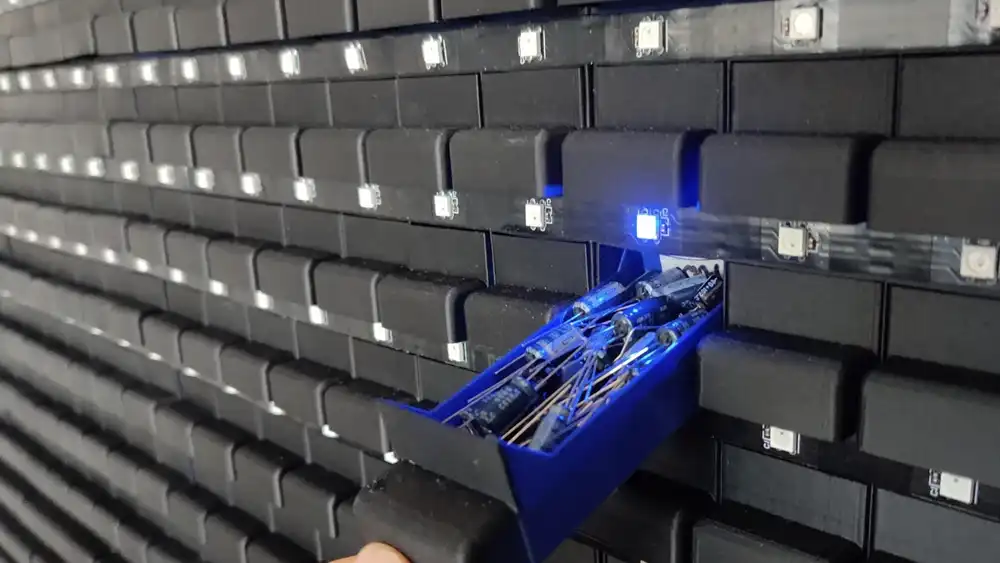
Organizing electronic components is essential for maintaining a productive and efficient workspace.
Here are some valuable tips to help you optimize your organization system:
- Sort by Type: Start by sorting your electronic components by type, such as resistors, capacitors, transistors, etc. This classification makes it easier to locate specific components when needed and prevents confusion during projects.
- Utilize Storage Containers: Invest in storage containers such as bins, drawers, or boxes to keep your components organized. Transparent containers are particularly useful as they allow you to see the contents at a glance, saving time when searching for specific items.
- Label Everything: Implement a labeling system for your storage containers to clearly identify the contents. Use labels with detailed information including component type, value, and quantity. This helps prevent mix-ups and ensures accurate inventory management.
- Use Adjustable Dividers: If possible, choose storage containers with adjustable dividers or compartments. This allows you to customize the size of each section to accommodate different component sizes and quantities effectively.
- Group Similar Items Together: Keep related components together to streamline the organization process. For example, group resistors of similar values in one container and capacitors in another. This reduces the time spent searching for components and enhances workflow efficiency.
- Designate Storage Areas: Designate specific storage areas for different types of components within your workspace. For example, reserve one shelf for passive components and another for active components. This systematic approach makes it easy to find what you need and minimizes clutter.
- Regular Maintenance: Schedule regular maintenance sessions to review and update your organization system. Periodically check your inventory for outdated or unused components and remove them to free up space. This prevents overcrowding and ensures that your organization system remains efficient over time.
- Invest in Modular Storage Solutions: Consider investing in modular storage solutions that can adapt to your changing needs. Modular storage systems allow you to add or remove compartments as needed, providing flexibility as your component collection grows.
- Keep Frequently Used Items Accessible: Store frequently used components in easily accessible locations within your workspace. This minimizes the time spent searching for commonly used items and helps maintain productivity during projects.
- Maintain a Clean Workspace: Keep your workspace clean and clutter-free to maximize efficiency and productivity. Regularly remove dust and debris from storage containers and work surfaces to prevent damage to electronic components and equipment.
- Consider Storage Temperature: Be mindful of the storage temperature for electronic components, especially those sensitive to heat or cold. Extreme temperatures can degrade component performance or lead to premature failure. Store components in a climate-controlled environment within the recommended temperature range specified by manufacturers.
Why is an Environment-Controlled Warehouse Vital for Electronic Components?
An environment-controlled warehouse is vital for electronic components due to several critical reasons:
Temperature Regulation: Electronic components are sensitive to temperature fluctuations. Extreme heat or cold can degrade component performance and even cause irreversible damage. By maintaining a controlled temperature environment, typically within a specified range recommended by manufacturers, the warehouse ensures that components remain stable and operational.
Moisture Control: Moisture is another major concern for electronic components, as it can lead to corrosion, short circuits, and other malfunctions. An environment-controlled warehouse helps regulate humidity levels, preventing moisture from accumulating and safeguarding components from potential damage.
Protection from Contaminants: Dust, dirt, and other contaminants pose a significant risk to electronic components, particularly those with delicate internal circuitry. A controlled environment minimizes the presence of airborne particles, reducing the risk of contamination and prolonging the lifespan of components.
Prevention of Electrostatic Discharge (ESD): Electrostatic discharge is a common hazard in electronics manufacturing and storage facilities. It occurs when accumulated static electricity is discharged, potentially damaging sensitive electronic components. An environment-controlled warehouse implements ESD prevention measures such as antistatic flooring, grounding straps, and ionizers to mitigate this risk and ensure component integrity.
Preservation of Shelf Life: Many electronic components have a limited shelf life, especially if exposed to adverse environmental conditions. By storing components in a controlled environment, the warehouse helps preserve their shelf life and ensures that they remain viable for use in future projects.
Compliance with Industry Standards: In industries such as aerospace, defense, and medical devices, stringent quality and reliability standards dictate the storage conditions for electronic components. An environment-controlled warehouse ensures compliance with these standards, providing assurance to customers and regulatory authorities regarding the integrity and reliability of stored components.
Minimization of Product Losses: The cost of electronic components can be significant, and any losses due to damage or degradation can have a substantial financial impact. An environment-controlled warehouse minimizes the risk of product losses by providing optimal storage conditions that mitigate the likelihood of component failures or obsolescence.
An environment-controlled warehouse is vital for electronic components because it ensures temperature stability, controls moisture levels, protects against contaminants and ESD, preserves shelf life, complies with industry standards, and minimizes product losses. By investing in such facilities, companies can safeguard their valuable inventory and maintain the quality and reliability of their electronic components.
DIY Organizational Solutions
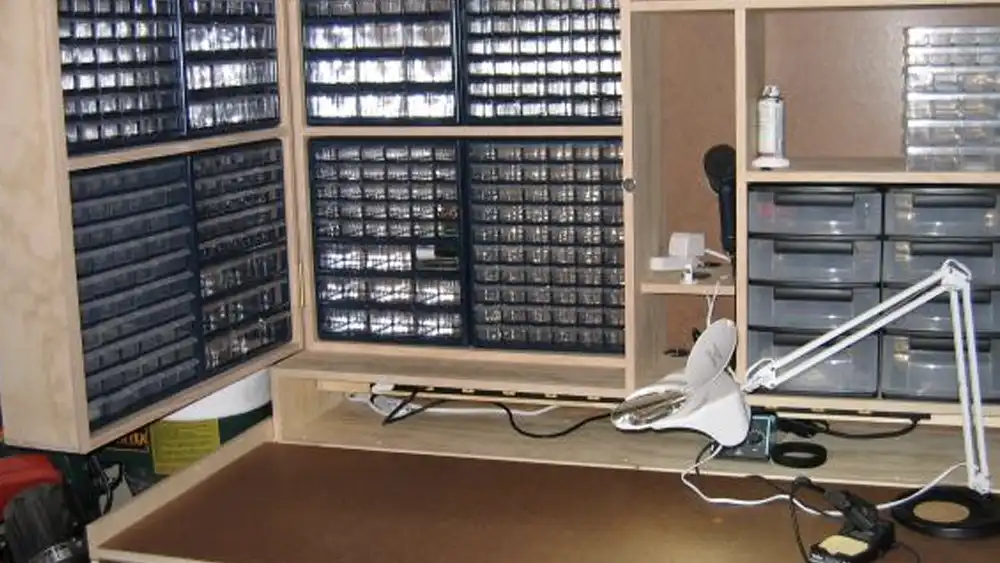
If you’re on a budget or enjoy a hands-on approach, DIY electronic component storage solutions offer a cost-effective and customizable alternative to commercial options. Here are some creative DIY ideas to help you organize your electronic components:
- Customized Storage Containers: Repurpose everyday items such as pill organizers, ice cube trays, or tackle boxes to store small electronic components like resistors, capacitors, and LEDs. These containers are readily available, inexpensive, and offer convenient compartmentalization for sorting components by type or value.
- 3D-Printed Organizers: Leverage the power of 3D printing technology to create customized storage organizers tailored to your specific needs. Design and print trays, bins, or drawers with adjustable dividers to accommodate different component sizes and quantities. With a 3D printer and some creativity, the possibilities are endless.
- Reused Household Items: Look around your home for unused or underutilized items that can be repurposed for electronic component storage. Empty spice containers, jewelry boxes, or craft organizers can be transformed into storage solutions with a little creativity and ingenuity. Not only does this approach save money, but it also gives a second life to household items that would otherwise go to waste.
- Cardboard Box Dividers: Transform ordinary cardboard boxes into organized storage solutions by creating dividers using cardboard or foam board. Cut and assemble dividers to fit snugly inside the box, creating compartments for different types of components. This simple yet effective DIY method allows you to customize the size and layout of each compartment according to your storage needs.
- Reuse Packaging Materials: Save and repurpose packaging materials from electronic devices or online orders to store and protect your electronic components. Anti-static foam inserts, blister packs, or bubble wrap can be used to cushion and secure delicate components, preventing damage during storage or transportation. Not only does this approach save money, but it also reduces waste by giving packaging materials a second purpose.
- Wooden Storage Shelves: Build your own wooden storage shelves or racks to organize larger electronic components such as breadboards, tools, or equipment. Use plywood, lumber, or reclaimed wood to construct sturdy shelves with adjustable heights to accommodate different-sized items. Add labels or markings to each shelf to facilitate easy identification and retrieval of components.
- Repurposed Drawer Organizers: Modify existing drawer organizers or cutlery trays to create dedicated storage spaces for electronic components. Arrange dividers to create compartments of varying sizes, allowing you to sort and organize components according to your preferences. Place the organizers inside drawers or on workbenches for easy access and organization.
Conclusion
In conclusion, organizing electronic components is essential for optimizing productivity, reducing costs, and prolonging component lifespan.
By adopting efficient storage solutions, implementing effective labeling systems, and staying abreast of emerging trends, individuals can create a workspace that fosters creativity and innovation. Whether you’re a hobbyist tinkering in your garage or a professional engineer in a high-tech lab, the principles of electronic component organization apply universally, ensuring smoother projects and greater peace of mind.
FAQs
How can I organize electronic components on a tight budget?
DIY solutions using household items like pill organizers or ice cube trays can be effective and affordable.
What is the best way to prevent damage to electronic components during storage?
Store components in anti-static containers or bags to protect them from electrostatic discharge.
How often should I update my organization system?
Regular maintenance is key. Aim to review and rearrange your inventory at least once every few months.
Are there any software tools available for managing electronic component inventory?
Yes, several inventory management software solutions cater specifically to electronics enthusiasts and professionals.
What should I do with obsolete electronic components?
Consider recycling programs or online platforms for selling or donating unwanted parts.